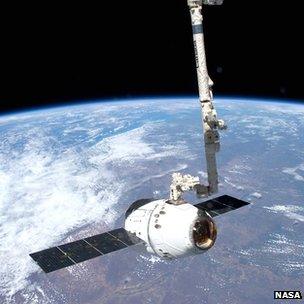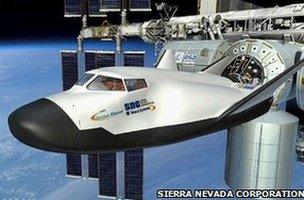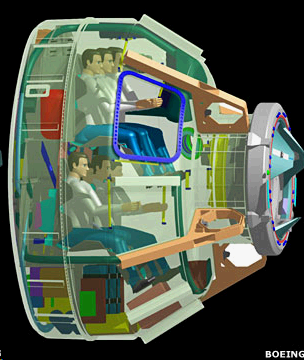Nasa announces space shuttle replacement shortlist
- Published

A Dragon made an unmanned flight to the space station in May
We now have a much clearer idea of how American astronauts will get into orbit in the coming years.
Nasa has selected three companies to help develop launch systems that can take people to the space station.
They include the SpaceX firm, which recently sent an unmanned cargo capsule to the 400km-high outpost.
But agreements have also been signed with aerospace giant Boeing and the Sierra Nevada Corporation. The latter has a design for a mini-shuttle.
The agency has been working with a number of partners in recent years to find spaceflight capabilities that could replace its own shuttle fleet, which retired last year.
Friday's announcement represented a reduction to concepts Nasa now thinks are best placed to deliver it a space transportation solution in the near-term.
The agency's intention is to eventually outsource its crew launch requirements to the private sector.
It hopes this will save it significant sums of money. At the moment, the US has no means of getting its own astronauts into orbit and purchases rides on Russia's Soyuz rockets at $60m a seat.
Refining designs
The US space agency is giving Friday's selected companies what amounts to 21 months of further seed funding under an initiative called CCiCap - its Commercial Crew Integrated Capability (CCiCap) programme.

SNC's vehicle is called the Dream Chaser
This will help the firms refine the technologies needed to introduce their launch systems.
Space Exploration Technologies (SpaceX) of Hawthorne, California, will receive $440m to help it progress the design of the Dragon capsule. It launches on the company's Falcon rocket and made history in May by becoming the first commercially developed vehicle to visit the International Space Station.
But Dragon must have life-support systems put in it before it can carry people. SpaceX also needs to develop a safety abort mechanism that could push Dragon off and away from the Falcon if the rocket suffers a major malfunction.
The Sierra Nevada Corporation of Louisville, Colorado, will get $212.5m. It is developing an old Nasa design for a seven-seat, winged space vehicle. Although it resembles the old shuttles, it is much smaller.

Boeing has immense heritage in the space sector
Unlike SpaceX, which has its own rocket, SNC would use the Atlas 5 launcher, which has an excellent reliability record in putting up military and scientific satellites.
The Boeing Company, of Houston, Texas, has a long heritage in providing space technology for Nasa. It will receive $460m. It will use this to refine its CST-100 capsule concept. It too will use the Atlas 5 to get off Earth.
"We will not only have diversity in systems, but also redundancy and competition as we move forward," said Ed Mango, Nasa's commercial crew programme manager.
CCiCap was devised for the purpose of identifying a complete launch system - not just a crew "taxi", but a rocket to launch it, and all the necessary ground support operation.
The notable absentee in the list is the ATK-led consortium. Magna, Utah-based ATK has proposed a rocket and capsule system called Liberty.
With Lockheed Martin and Europe's biggest space company, Astrium, also involved - the consortium had appeared to be a strong contender for CCiCap support.
Jonathan.Amos-INTERNET@bbc.co.uk and follow me on Twitter, external
- Published31 May 2012
- Published10 May 2012